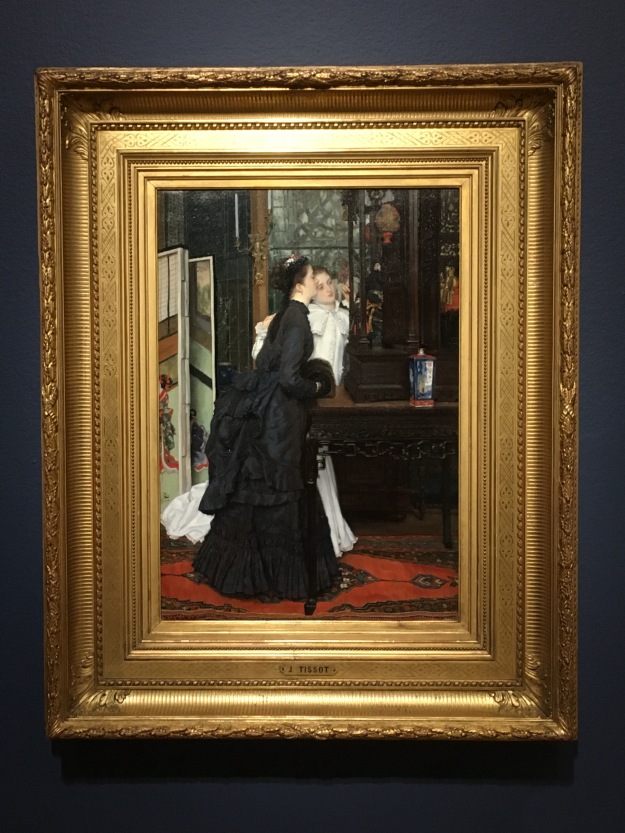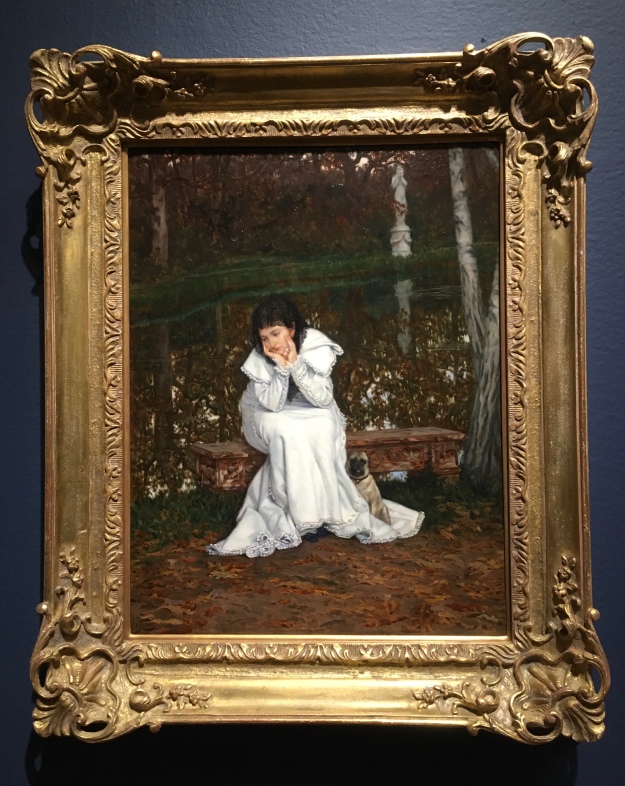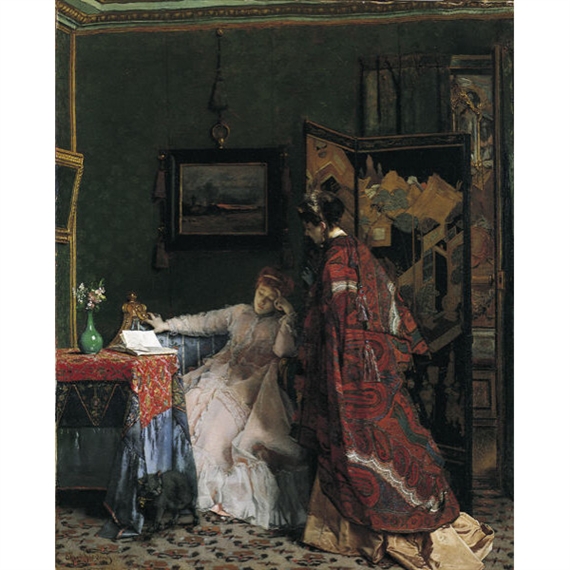To cite this article: Paquette, Lucy. “Lounging around with James Tissot.” The Hammock. https://thehammocknovel.wordpress.com/2020/08/14/lounging-around-with-james-tissot/. <Date viewed>.
What do you wear when lounging around the house?
In England in 1866, you might have kept cozy in this colorful twill wool dressing gown with a printed cashmere pattern, now in the collection of the Kyoto Costume Institute.

Portrait of the Marquise de Miramon, née, Thérèse Feuillant (1866), by James Tissot. Oil on canvas, unframed: 50 1/2 by 30 3/8 in. (128.3 by 77.2 cm). The J. Paul Getty Museum, Los Angeles. Digital image courtesy of the Getty’s Open Content Program.
In Portrait of the Marquise de Miramon (1866), James Tissot depicts the 30-year-old Marquise in her sitting room in her husband’s castle, the château de Paulhac in Auvergne, wearing a pink silk velvet peignoir. The bright pink color was produced with a modern aniline dye, newly available in the past half-dozen years. Ruffles of an even brighter pink trim every edge, including the loose, flared sleeves cut to the elbow on the outside. Under this elaborate, caped and trained dressing gown, she wears a white lace chemise or nightdress with full, three-quarter length sleeves ending in a deep gathered ruffle. She has loosely tied a chic black lace scarf at her throat, which accents her silver cross pendant – her sole piece of jewelry. She wears a white cotton glove edged in a narrow scalloped ruffle; the mate rests on the mantel. A shining black leather shoe peeps out beneath her gown.
 Three years later, in Young women looking at Japanese objects (1869), Tissot features another peignoir – this one in a heavy white fabric (perhaps cotton), and much simpler than the Marquise’s. This peignoir, also caped, is trimmed in white bobble fringe and has a column of white buttons, perhaps abalone shell, from the throat to the hem. The cape, side pocket slits, and hem are accented with a narrow crimson stripe. A small gathered lace ruffle of the white underdress is visible under the round collar, as is the pleated ruffle at the edge of the long sleeves.
Three years later, in Young women looking at Japanese objects (1869), Tissot features another peignoir – this one in a heavy white fabric (perhaps cotton), and much simpler than the Marquise’s. This peignoir, also caped, is trimmed in white bobble fringe and has a column of white buttons, perhaps abalone shell, from the throat to the hem. The cape, side pocket slits, and hem are accented with a narrow crimson stripe. A small gathered lace ruffle of the white underdress is visible under the round collar, as is the pleated ruffle at the edge of the long sleeves.

Young Women looking at Japanese objects (1869), by James Jacques Joseph Tissot. Oil on canvas, 27.75 by 19.75 in. (70.5 by 50.2 cm). Cincinnati Art Museum, Ohio, USA; Gift of Henry M. Goodyear, M.D. Courtesy of The Bridgeman Art Library for use in “The Hammock: A novel based on the true story of French painter James Tissot,” by Lucy Paquette © 2012
In one of two variations of this composition, Young women looking at the Chinese temple (1869), the white peignoir functions as a light background for the dark visiting gown worn by the figure in front.

Young women looking at the Chinese temple (1869), by James Tissot. Oil on canvas, 22 by 15.5 in. (55.9 by 39.4 cm). Private collection.
The white bobble-fringed peignoir reappears in The Staircase (L’escalier, 1869) and Melancholy (Mélancolie, c. 1869).

The Staircase (L’escalier, 1869), by James Tissot. Oil on canvas, 22 by 15 in. (55.9 by 38.1 cm). Pérez Simón Collection, Mexico City. (Photo by Lucy Paquette)
The model’s pose in The Staircase shows off the bobble trim on the sleeves and along the edge of the train, while a black ribbon at her throat accents and helps define the collar.

Melancholy (Mélancolie, c. 1869), by James Tissot. Oil on panel, 19.5 by 14.75 in. (49.5 by 37.5 cm). Collection of Ann and Gordon Getty. (Photo by Lucy Paquette)
Melancholy displays the garment’s ruffled cuffs and sleeves, as well as how it fits when the wearer is seated, and we finally glimpse the little black slippers she wears with it. The thickness and weight of the fabric is evident in this picture.
Tissot’s choice of the white peignoir, visually interesting while a versatile compositional device, was shrewd.
In his friend Alfred Steven’s painting, The Visit (c. 1869), the ornate pattern of white lace over the pale pink dressing gown works in this composition’s complicated interplay of color, pattern, shape and line.
But in Stevens’ The Psyché (My Studio, c. 1871), the model who peers from behind the cheval mirror in his studio, wears a dressing gown startling similar to the bobble-fringed costume Tissot used to such advantage. Its solid white is a successful foil to the colors and patterns surrounding her. Rather than the bobble trim, a black edging defines the edges of its caped collar, graceful hem, and cuffs, which are punctuated by three black buttons. And at her throat, she wears a chic black scarf, just as Tissot portrayed on the Marquise de Miramon.
Related posts:
A Closer Look at Tissot’s “Young Women Looking at Japanese Articles”
The Artist’s Closet: James Tissot’s Prop Costumes
James Tissot’s Fashion Plates (1864-1878): A Guest Post by Lucy Paquette
James Tissot and Alfred Stevens
© 2020 by Lucy Paquette. All rights reserved.
The articles published on this blog are copyrighted by Lucy Paquette. An article or any portion of it may not be reproduced in any medium or transmitted in any form, electronic or mechanical, without the author’s permission. You are welcome to cite or quote from an article provided you give full acknowledgement to the author.

If you do not have a Kindle e-reader, you may download free Kindle reading apps for PCs, Smartphones, tablets, and the Kindle Cloud Reader to read The Hammock: A novel based on the true story of French painter James Tissot.
The Hammock: A novel based on the true story of French painter James Tissot, brings Tissot’s world from 1870 to 1879 alive in a story of war, art, Society glamour, love, scandal, and tragedy.
Illustrated with 17 stunning, high-resolution fine art images in full color
Courtesy of The Bridgeman Art Library
(295 pages; ISBN (ePub): 978-0-615-68267-9). See http://www.amazon.com/dp/B009P5RYVE.

